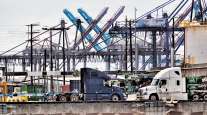Trade Groups Grapple With Chassis Supply Fee Issues
This story appears in the May 16 print edition of Transport Topics.
Nearly two years after Maersk Line, the world’s largest ocean carrier, shook up the system for delivering freight containers from U.S. ports by requiring drayage truckers for the first time to pay rental fees for chassis, three trade groups are trying to foster an orderly transition to a new intermodal reality.
The Intermodal Association of North America, the Ocean Carrier Equipment Management Association and the National Industrial Transportation League are making those efforts against a backdrop of uncertainty about who will provide and pay for at least 550,000 international container chassis in service.
Since Maersk in June 2009 created its Direct ChassisLink Inc. (DCLI) subsidiary to collect an $11-a-day chassis-use fee, some other ocean carriers such as Japan’s NYK Line said they would stop supplying free chassis. Other ocean carriers didn’t change policies at all ports or set schedules for halting free chassis supply that stretch late into 2012. Still others, such as Mitsui O.S.K. Lines, haven’t announced any changes.
“It is going to be a difficult conversion for everyone involved,” said William Rooney, a maritime executive for 37 years, speaking on a
May 4 webinar sponsored by NITL. “The danger may be in the transition — how does everybody transition from one paradigm to the next without dropping the ball?”
Maersk began charging for rentals after the federal government published regulations making owners of chassis responsible for inspecting and maintaining the rigs, at the urging of the nation’s trucking industry.
IANA, which includes railroads, ocean carriers, truckers and suppliers, formed a working group to tackle operational complexities that will arise as the future supply of chassis and containers come from separate sources instead of having both pieces of equipment come from ocean carriers.
Meanwhile, OCEMA created a website where truckers and shippers can see each line’s chassis plans as part of an information campaign, and NITL, a shipper group, moved to educate its members through its webinar.
Rooney highlighted the multiple effects on the chassis business, which ocean carriers say cost them up to $2 billion a year.
“Shippers don’t want to pay extra for chassis,” Rooney said. “If people are paying $11 a day for chassis, they are going to change operations pretty quickly.
“Truckers are caught in the middle between shippers and carriers,” he said. “Some want to own chassis, but most do not. Their [profit] margins don’t allow them to absorb the cost of chassis.”
“The [ocean] carriers will exit [the chassis business],” Rooney predicted. “That does not mean it will be uniform. The question is, what will happen during the rest of this year — will carriers in a material way get out of the chassis business?”
Against that backdrop, IANA formed the Chassis Working Group “to understand the emerging issues among all the stakeholders and to see how the operating complexities can be addressed,” IANA Vice President Thomas Malloy told Transport Topics.
Participants in the working group include OCEMA, chassis lessors, DCLI and representatives of port and rail interests. Also included is American Trucking Associations’ Intermodal Motor Carriers Conference. Curtis Whelan, executive director of ATA’s conference, was not available for comment.
“IANA members have said we need a centralized data warehouse,” Malloy said, because of the potential for draymen to receive chassis and international containers from separate parties instead of the single source — the ocean carrier — that traditionally has provided them.
IANA’s goal is to create standardized procedures for exchanging information about chassis in the same way that it already provides a mechanism for ocean and motor carriers to hand off containers between carriers, Malloy said.
“Having a uniform approach bodes well for the industry,” he said, because that would mitigate delays in terminals where the chassis actually change hands and avoid the complications that result if each ocean and motor carrier has a separate agreement.
Ocean carriers stressed information and reassurance.
“There was a concern [among ocean carrier members] there might be disruptions to the supply chain,” OCEMA’s executive director, Jeffrey Lawrence, told TT, as ocean carriers stopped providing chassis. He also said members were concerned that the process was confusing to shippers and truckers.
In addition to the working group activity, OCEMA has posted port-by-port chassis transition plans for 14 of its 20 members. The other six haven’t publicly announced any changes.
The shared concern among shippers, motor carriers, railroads and terminal operators, Lawrence said, was “How will we assure that there are an adequate number of chassis?”
“The chassis are going to stay,” he said. “The entity providing them may be different.”
At the same time, OCEMA’s Consolidated Chassis Management subsidiary, which operates a fleet of 120,000 chassis provided by ocean carriers, is making several changes to address any supply concerns.
Those changes include implementing a common chassis management system for CCM’s six pools that operate separately today in order to boost efficiency. CCM also is creating flexibility to meet surges by moving chassis from one pool to another for the first time.
“The one important thing to note about changing a chassis provision model is that it’s an individual [ocean] carrier decision,” Lawrence stressed. Malloy made a similar point, saying IANA’s group intends to create common procedures and not dictate commercial terms.
The fact that there has been little apparent resolution of the chassis issue during annual contract negotiations that are in progress now is adding to the current uncertainty, Rooney said.




